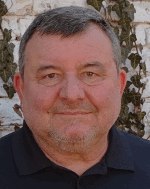 |
|
Biography
D.Sc. Dr. Mihail Nedjalkov, born in Sofia, Bulgaria received the Master degree in semiconductor physics at the Sofia University "Kl. Ohridski", a Ph.D. (Dr.) degree in Physics (1990), Habilitation (2001) and Doctor of Science (D.Sc.) degree in Mathematics (2011) at the Bulgarian Academy of Sciences (BAS). He is Associate Professor with the Institute of Information and Communication Technologies, BAS. He held visiting research positions at the University of Modena (1994), University of Frankfurt (1998), Arizona State University (2004) and mainly at the Institute for Microelectronics, TU-Vienna, supported by the following European and Austrian projects: EC Project NANOTCAD (2000-03),"Österreichische Forschungsgemeinschaft MOEL 239 and 173 (2007-08), FWF (Austrian Science Fund) P13333-TEC (1998-99), P21685-N22 (2010-2014), P27214-N27(2017- date), START (2005-06), P-21685 (2009-2014), EC-FP7 Project SUPERTHEME and the current H2020 Project SUPERAID7. He has served as a lecturer at the 2004 International School of Physics 'Enrico Fermi', Varenna, Italy, and has over 160 publications. His research interests include physics and modeling of classical and quantum carrier transport in semiconductor materials, devices and nanostructures, collective phenomena, theory and application of stochastic methods.
Electron-Dopant Potential Interaction in Nanowires
We applied the 2D Quantum-Wigner simulator, ViennaWD, to investigate quantum effects in the electron evolution around a repulsive dopant in a nanowire. The Wigner formalism ensures a seamless transition between quantum and classical descriptions and thus allows one to conveniently study the role of coherent processes using the classical Boltzmann picture as a reference frame. Both Wigner and Boltzmann formalisms are modeled by stochastic particles, which evolve in phase space. Quantum particles bear most of the properties of the classical Monte Carlo model, such as Newtonian trajectory and ensemble averaging. However, novel concepts, like particle sign, generation and annihilation, are introduced to account for the quantum information in the system. An important difference is that, while classical particles are accelerated by a force, which is the first derivative of the dopant potential, the quantum counterparts are subject to the influence of the entire potential, namely all derivatives in the corresponding Taylor expansion take part in the interaction. The potential acts to produce tunneling and non/local effects.
The analyzed electron evolution is a result of the complicated interplay of tunneling, non-locality and the boundary conditions imposed by the wire. Since the interaction is energy conserving, it is sufficient to focus on the zeroth and first moment of the classical and quantum (quasi-) distributions, namely the electron density and the current density. The wire is represented by injecting and absorbing boundaries along the transport direction and lateral reflecting boundaries, which may be switched on and off in order to study their effect. Coherent Wigner states, corresponding to minimal uncertainty wave packets, are periodically injected to avoid the de-cohering role of the standard Ohmic boundary conditions.
In the quantum case, these states correspond to single electrons. While, from a classical point of view, these are ensembles of electrons having Gaussian distribution, the non-local evolution is affected by repulsion in a region before the area where classical particles feel the force of the dopant, while tunneling is evidenced by the appearance of a non-zero density in the region where classical density is zero. This is due to the shadow of the dopant. The analysis shows that particles that are repulsed before reaching the dopant particles are reflected by the boundary conditions and then enter the repulsive region behind the the dopants and thus are also accelerated to increase the current in the quantum case.



